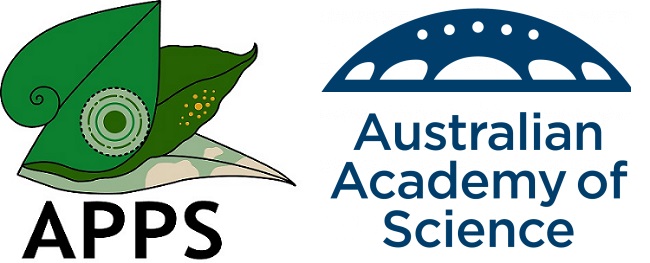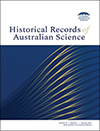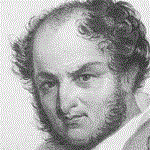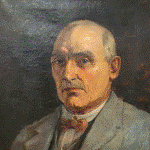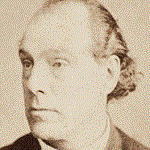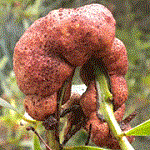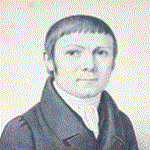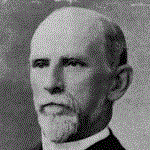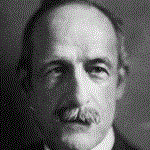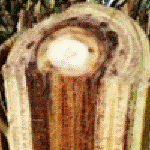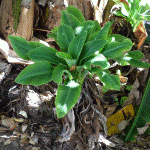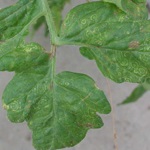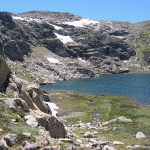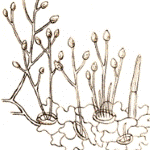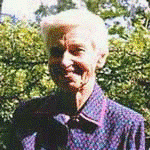Historical Records of Australian Science
Volume 35
Number 2 2024
Special Issue
History of Plant Pathology in Australasia
HRv35n2tocTable of Contents
Grain production in the early years of colonisation in Australia was hampered by poor farming practices, lack of livestock, and belligerent, unenthusiastic convict labour. In 1803, just when the situation began to improve, stem rust of wheat was discovered by the exiled Irish rebel ‘General’ Joseph Holt on Brush Farm, owned by Captain William Cox. The disease, which has remained a threat to wheat production ever since, found its way into ironic Australian literature, including Ned Kelly’s Jerilderie letter. Photograph from an original picture in the possession of Sir William Bentham painted in 1798, Day & Haghe lithrs. to the Queen, Trove, https://trove.nla.gov.au/work/22823177. Accessed August 2021.
Darnell-Smith developed a dry treatment for controlling the hitherto severe wheat disease common bunt. His groundbreaking work was done during the First World War in field experiments at Wagga Wagga and Cowra and widely reported in Australian newspapers. The treatment with copper carbonate dust was highly effective and simpler to apply than the previously used ‘wet pickles’. Despite this, uptake by farmers was slow until popularised in America so that by 1930 bunt had become a rarely seen disease. Photography by Dr Jordan Bailey.
Among the fungi recorded in a paper published in the 1880 Proceedings of the Linnaean Society of New South Wales was Sphaerella destructiva, now Pseudopeziza medicaginis, the cause of common leaf spot of lucerne. The paper, co-authored by the naturalist Reverend Julian Tenison-Woods and the Queensland Government Botanist Frederick Manson Bailey was the first known comprehensive list of Australian fungi published by Australian residents. It is a milestone in the evolution of mycology and plant pathology studies in Australia. Photograph by H. H. Baily.
The wattles (Acacia species) are an ancient and iconic Australian genus of trees and shrubs which form part of the identity of the nation. Galls were a common feature on wattle trees, initially being attributed to the activity of some insects, but later a genus of rust fungi, Uromycladium, was found to also cause galls. The lives of two of the early collectors of wattle rust galls, Otto Tepper and Charles Brittlebank, are also illuminated in this paper. Photograph by Alastair McTaggart.
In the early 1890s a serious mystery disease appeared in pineapple plantations around Brisbane, Queensland. The American-born Professor Edward Shelton, Queensland’s first instructor in agriculture, Henry Tryon, assistant curator at the Queensland Museum, and others inspected diseased plants and concluded that the disease was caused by a fungus, later identified as the oomycete Phytophthora cinnamomi. Shelton went on to become the first principal of the Gatton Agricultural College, but was forced to resign after severely disciplining some of the students. Photograph by an unknown person.
In 1894, the Queensland government entomologist, and later vegetable pathologist, Henry Tryon (1856–1943) discovered a new disease that caused potato tubers to become rotted and putrid. He consistently found bacterial cells in a thick mucilaginous gum in the vascular tissues of wilted stems and infected tubers, and gave it the name Bacillus vascularum solani. The American bacteriologist Erwin Frink Smith would not accept Tryon’s discovery, instead naming the causal agent Pseudomonas solanacearum. That bacterium, now called Ralstonia solanacearum is a significant plant pathogen worldwide. Photograph by an unknown person.
At the start of the decade of 1890, sugarcane growers in southern Queensland and northern New South Wales began to notice a serious disease affecting their crops. American-born Nathan Cobb, who was the New South Wales Government Vegetable Pathologist, discovered that a bacterium, now known as Xanthomonas axonopodis pv. vasculorum, was the cause of the disease. Although others were not convinced that Cobb had conclusively proved that the bacterium was the causal agent, it was for many years known as ‘Cobb’s gumming disease of cane’.
Within the first forty years of English colonisation of Australia, the climate of Queensland proved to be the ideal place for the commercial production of bananas. It was in the south-eastern corner of the state that a new disease of banana (now called Fusarium Wilt) was identified by a Brisbane physician, Dr. Joseph Bancroft, in the early 1870s. The disease was given the name ‘Panama disease’, despite the fact that it was not discovered in Panama until twenty years later. Photograph by Andre Drenth.
Banana bunchy top disease is the most serious viral disease of bananas in the world, and nearly wiped out the Australian banana industry in the early twentieth century. The impacts of the disease epidemic were hardest felt by veterans of World War 1, who moved to the Northern Rivers region of New South Wales to create a subtropical fruit industry as part of the Soldier Settlement Scheme. This article describes the early history of the Australian banana industry, the introduction and spread of bunchy top disease, and efforts to develop a disease management plan. Photograph by Scot C. Nelson, University of Hawaiʻi.
This article belongs to the Special Issue: History of Plant Pathology in Australasia.
Tomato spotted wilt virus (TSWV) is one of the most economically important viruses in the world. Before it became a global problem, it devastated tomato crops in Australia. This paper describes how TSWV was identified and biologically characterised by Australian scientists at a time when few techniques existed to detect the virus. It is a remarkable story of human endeavour by a small team of people working in academic isolation.
Rupert Jethro Best, working alone in Adelaide at the Waite Agricultural Research Institute, was among the first to purify tobacco mosaic virus and to provide evidence that it was a heterogeneous macromolecule, composed mainly of protein but also small prosthetic groups with the properties of a weak acid, wherein lay the activity of the virus. This paper describes the contributions of Rupert Best to early theories on the material nature and mode of reproduction of viruses. Photographer unknown, State Library of South Australia.
A chance discovery in alpine Australia in 1980 led to the discovery of a virus in a remote and rare species of plant. The virus has clear connections with a virus in the Northern Hemisphere. The way we study plant virology has changed over the intervening years but the mystery as to how the virus got there remains. Photograph by: PL Guy 2004.
Late blight, ultimately shown to be caused by the oomycete Phytophthora infestans, devastated potato crops in Ireland and other countries in Europe during the mid-late 1840s. In 1909 the disease was positively identified in Australia by the Queensland Vegetable Pathologist, Henry Tryon, who had compelling evidence that the source of the disease outbreaks was planting tubers from Tasmania. Growers and authorities in that state refused to believe the accusation but were soon proved wrong. Image credit: J. M. Berkeley (1846).
This is the story of how the Australian Government has been protecting Australia’s remote northern coastline from biosecurity invasions from neighbouring countries. It is a story of boots on the ground plant health surveillance across Australia’s north and also over the horizon, in the countries that lie so close to our northern shore. Key to success has been collaborative field work overseas, with biosecurity scientists of Indonesia, Timor Leste, Papua New Guinea and Solomon Islands. Photograph by Kerry Trapnell.
Gretna Weste was a woman plant pathologist who pioneered research on dieback, a devastating new disease of forests in southern Australia, in the late twentieth century. Weste’s research was foundational in the recognition of dieback disease as a Key Threatening Process for Australia’s natural biodiversity in 2000. Her career illustrates the significant gender-based obstacles faced by women scientists in Australia, and the stoic strength demonstrated by Weste. Photographer unknown.
